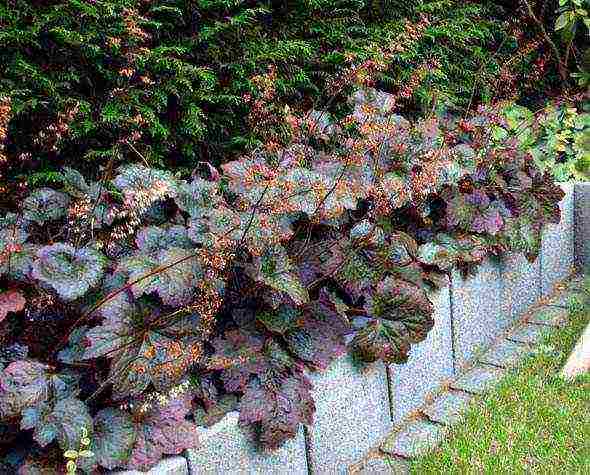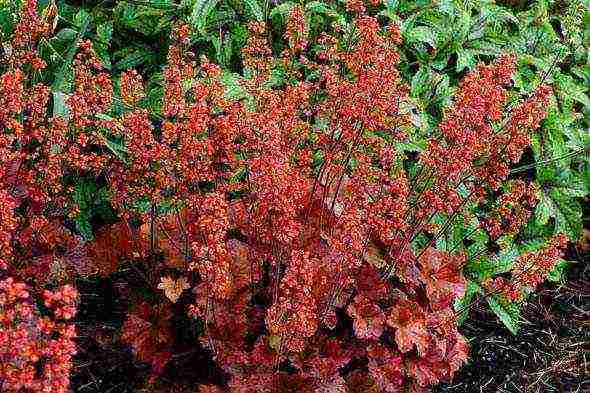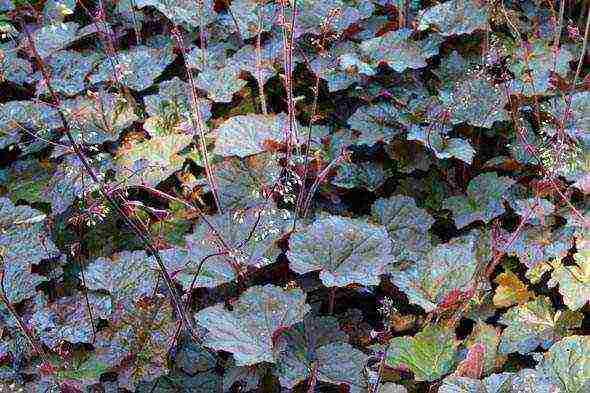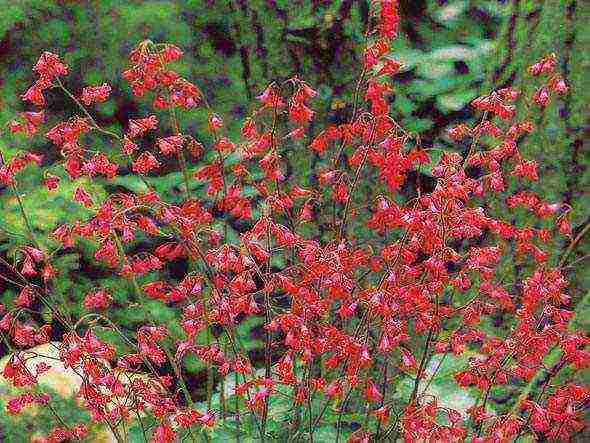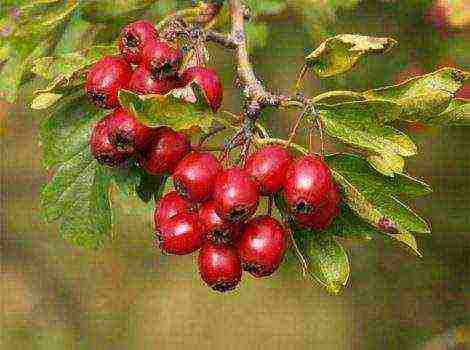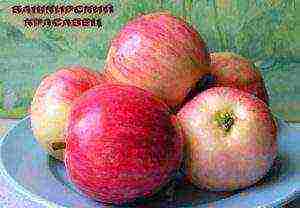Content
- 1 Green Spice
- 2 Glitter
- 3 Delta Don
- 4 Ginger Ale
- 5 Georgia Peach
- 6 Marmalade
- 7 Midnight Rose
- 8 Paris
- 9 Forever Purple
- 10 Electra
- 11 Botanical characteristics of Heuchera
- 12 Color harmony in landscape design
- 13 Surrounded by charming varieties of Heuchera
- 13.1 The unsurpassed blood-red Heuchera
- 13.2 "Tasty" Heychera Marmalade
- 13.3 Purple Heuchera Forever Purple
- 13.4 Fire Heuchera Cajun Fire
- 13.5 Gentle Heuchera Cherry Cola
- 13.6 Silver Heuchera Glitter
- 13.7 "Sweet" Heuchera Caramel
- 13.8 Majestic Heychera Purple Castle
- 13.9 Another purple beauty - Heychera Melting Fire
- 13.10 Multicolored Heuchera Zipper
- 13.11 Spotted Heuchera Midnight Rose
- 13.12 Geichera Palace Purple
- 13.13 Geichera Hybrid
- 13.14 Geichera Comet
- 13.15 Wonderful Heuchera in the garden - video
This article contains a list of beautiful and easy-to-care varieties of Heuchera with photos, tables and a detailed description. We are sure that you will certainly find something for your garden.
Heuchera is an amazing plant that can add color to even the darkest corners of the garden. She perfectly "gets along" with hosts, and also grows well in the shade of trees and bushes.
Green Spice
Green Spice is one of the most popular varieties of American Heuchera. At the beginning of the season, its leaves are green with a slight silvery sheen, malachite edging along the edge of the leaf and dark greenish-purple veins. Over time, the foliage is painted in ocher-red shades.
Green Spice achieves its maximum spectacular appearance in the shaded corners of the garden with moderate watering.
| Bush height (cm) | Bush width (cm) | Distance between plants (cm) | Flowering time | Lighting |
| 22-90 | 30-60 | 30-45 | End of May - beginning of July | Penumbra, shadow |
Glitter
Glitter (Glitter) is a hybrid of small-flowered and American heuchera. It attracts the eye with a fantastically beautiful color of the leaves: from the outside they are silvery-purple and deep purple - from the inside.
It is best to plant Heuchera Glitter on the northeastern side of the site in the near-trunk circles of trees and tall shrubs, as it does not like bright sunlight.
| Bush height (cm) | Bush width (cm) | Distance between plants (cm) | Flowering time | Lighting |
| 20-25 | 30-35 | 30-40 | End of May - June | Penumbra, shadow |
Delta Don
Heicher Delta Dawn is not afraid of any misfortunes: no diseases, no pests, no dry and hot summer weather, no rainy summer. This herbaceous perennial feels great in shady and semi-shady corners of the garden, but it can grow in well-lit areas, although in this case its leaves will lose a little in beauty and presentability. And there really is something to lose!
During the season, the color of the leaves of this heuchera changes from lime with red veins to red with a golden yellow border around the edges.
Delta Don bushes are compact enough. Ideally, they are planted in groups of willow mixborders, rockeries, at the foot of alpine hills.
| Bush height (cm) | Bush width (cm) | Distance between plants (cm) | Flowering time | Lighting |
| 20-30 | 25-30 | 22-30 | June July | Sun, partial shade, shadow |
Ginger Ale
Geykhera Ginger Ale ("ginger ale") really reminds of this golden drink in its color. This plant boasts amber leaves with coral veins and a slight silvery sheen.
Ginger Ale bushes do not like bright sun and feel more comfortable in shaded areas with fertile, moist soil. Heucheras of this variety can tolerate both dry and rainy summer months.
| Bush height (cm) | Bush width (cm) | Distance between plants (cm) | Flowering time | Lighting |
| 20-30 | 25-30 | 22-30 | End of May - June | Penumbra, shadow |
Georgia Peach
Geichera varieties Georgia Peach (Georgia Peach) is valued for its high resistance to heat, drought and excessive soil moisture at the same time. The plant is no less attractive for its spectacular appearance. The leaves of this heuchera change color several times during the summer. At the beginning of the season, they are peach-orange with dark red veins and a slight silvery "dusting"; as they grow, they acquire an increasingly distinguishable pink hue, and by the beginning of autumn they become pinkish-purple.
Georgia Peach blooms in the first half of summer. It is advisable to regularly pick off wilted flowers.
This Heuchera can grow in sunny areas, but thrives best in full and partial shade.
| Bush height (cm) | Bush width (cm) | Distance between plants (cm) | Flowering time | Lighting |
| 30-90 | 30-60 | 45-60 | End of May - beginning of July | Sun, partial shade, shadow |
Marmalade
Unlike most varieties of this plant, it is highly undesirable to plant Marmalade Heuchera in full shade. She prefers the sun and "agrees" to tolerate only slight shading, so the ideal place for her is the southwest side of the site.
In plants of the Marmalade variety, the leaves are not of the most typical form for Heuchera: they are carved and a little like bells. Their color is pinkish-burgundy, moreover, the veins practically do not stand out against this background.
This Heuchera is not capricious and can be grown as a container plant.
| Bush height (cm) | Bush width (cm) | Distance between plants (cm) | Flowering time | Lighting |
| 30-90 | 30-60 | 45-60 | End of May - beginning of July | Sun, partial shade |
Midnight Rose
Heuchera Midnight Rose also adorns foliage of an unusual shade: it is purple-burgundy, sometimes almost black, strewn with bright pink splashes.
"Midnight rose" (this is how the name of the variety is translated from English) cannot be called capricious, but it is still advisable to protect it from lack of lighting and not plant it in areas with poor soil.
| Bush height (cm) | Bush width (cm) | Distance between plants (cm) | Flowering time | Lighting |
| 25-60 | 30-60 | 30-45 | End of May - July | Sun, partial shade |
Paris
Geuchera varieties with the romantic name Paris (Paris) are characterized by attractive mint-silvery foliage with green veins, but this plant is most prized for its charming bright pink flowers.
Geichera Paris is not afraid of pests and diseases, it is able to survive drought in summer and frost in winter. The main thing is to water it in a timely manner in the heat and additionally cover it in case of a severe cold snap.
| Bush height (cm) | Bush width (cm) | Distance between plants (cm) | Flowering time | Lighting |
| 17-30 | 30-60 | 30-40 | End of May - end of August | Penumbra, shadow |
Forever Purple
Geichera Forever Purple is notable for its luxurious purple foliage, which darkens over time, acquiring a purple-eggplant color. This purple beauty blooms with delicate pink flowers.
Forever Purple plants withstand severe winters and dry summers with dignity, do not impose special requirements on lighting.
| Bush height (cm) | Bush width (cm) | Distance between plants (cm) | Flowering time | Lighting |
| 25-30 | 50-55 | 50-60 | End of May - July | Sun, partial shade, shadow |
Electra
Electra is an American hybrid of Heuchera. Its leaves, at the beginning of the season, are yellow-green with dark orange veins, by the end of summer they acquire a peach hue. The bushes of this variety are unpretentious to care for, do not require shelter for the winter. The only requirement is to protect them from the bright sun in spring and summer, and also to water them regularly.
| Bush height (cm) | Bush width (cm) | Distance between plants (cm) | Flowering time | Lighting |
|
20-30 |
30-60 | 30-37 | End of May - June | Penumbra, shadow |
If you want to plant Heuchera in your garden, be sure to read our article on the secrets of caring for this beautiful and unpretentious ornamental plant.
For many years, the herbaceous perennial Heuchera has been unusually in demand in landscape design. Belongs to the family Saxifrage, genus rhizome. The homeland of the garden planting is considered to be a rocky area in the north of America. The appearance of the culture is a compact bush, reaching a height of no more than 50 cm. Leathery, serrated leaves are formed on long cuttings. The main decorative value is the incredibly beautiful and original leaves. This is the choice of gardeners who have a delicate taste and prefer sophistication and originality on their site.
Content:
- Varieties and types
- Combination with other plants
- Use in landscape design
- Reproduction, planting and care
- Video - Geichera planting in the garden and care
An interesting feature of the representative of the flora is the change in the color of the leaves during the growing season. Certain varieties do this several times per season. The palette of shades of all varieties is impressive even for sophisticated gardeners and landscape designers. In this regard, it is difficult for a geycher to find a competitor.
Varieties and types
More than 400 varieties are known today. With each new variety, more and more interesting types of flowers and original colors of leaves appear. That allows you to choose for your landscape exactly the option that best fits into the overall picture. The last varieties bred also change their color throughout the season. Only true connoisseurs know thoroughly all the names. There are 70 known species in the wild. Conventionally, heuchera is divided into two main types:
- forest;
- mountain.
Lesnaya
Prefers moist soil. To maintain the necessary moisture, the plant is mulched. Stagnant water has a detrimental effect on the garden planting. During planting, especially on clay soils, it is necessary to provide a drainage layer (fragments of bricks, gravel) and a baking powder (sand, compost). The most famous types:
Geichera American
- American... It was opened not so long ago. Outwardly, it is very similar to geraniums. The shape of the leaves is heart-shaped, the color is contrasting: lilac from the bottom and green from the top. The cuttings are long; rather large rosettes with attractive leaves and yellow-green panicles are formed on them.
Heuchera hairy
- hairy... The peduncle and the stalk have a lowered shape. Thanks to this, the plant got its name. Leaves are large, velvety to the touch. The most famous varieties: Palace Purpl.
- hybrid... Large openwork or semicircular leaves can be with or without patterns. A wide variety of shades. Popular varieties: marmalade, caramel, cherry cola, lime pie.
Geichera South American
- South American... Round leaves form a rosette up to 18 cm in size. The color of the leaves is contrasting: the bottom is purple, and the top is greenish. Peduncles reach 55 cm. There are small green flowers in panicles. The variability of the color of the leaves is manifested most often in autumn and spring. Then the leaves have a neat border of a red-coral shade. It becomes more noticeable in winter.
Mountain
These species are cold and drought tolerant. They do not tolerate stagnant moisture in the soil. Ideal for rock garden. The most famous types:
Geichera Blood red
- Heychera blood red... The leaves are rounded, the main color is green interspersed with beige. The socket is tight. Large flowers have a bright red color, their height is up to 50 cm. It is the prototype of the American Heuchera, actively used in landscape design. Popular varieties: red queen.
Geichera Cylindrical
- Heuchera cylindrical... This variety is larger than the others. The leaves are massive, decorated with a silvery pattern and contrasting veins. Peduncles are tall and large, white, coral, pink and green predominate. Thanks to a fairly short peduncle, large (up to 80 cm) flowers have an original floating appearance.
Geichera Small-flowered
- geychera small-colored... This is the most spectacular variety. The leaves, in shape, are similar to maple leaves. The purple color can be covered with a pattern - silvery threads. The plant is favorably set off by small flowers of a pale pink hue, collected in a panicle. Popular varieties: Peles Pearpl.
Geichera Gooseberry
- gooseberry heuchera... Due to its resistance even to severe frost, it is in extraordinary demand among gardeners in countries with cold climates and long winters. Its foliage does not fall no matter what, decorating the garden all year round.
Combination with other plants
Geichera is well tolerated by a company with many orchards. Most often it is planted next to astilba, bruner, chrysanthemum, ornamental grasses and cereals, daylilies, and veronica. In a mixborder, it is combined with a fern, hosta, geranium, primrose and iris.
Use in landscape design
A plant of such incredible beauty will decorate any, even the most unsightly, part of the garden. Leaves of an unusual shape and numerous shades are always planted in an honorable centerpiece in a flower garden. Geichera is ideal for group planting. She acts as a connecting thread in a mixborder, combining many plants into one ensemble. Neat and strict shape is well suited for creating beautiful borders. Can be planted in containers, flowerpots and decorate gazebos, recreation areas, patios with them.
Reproduction, planting and care
The plant propagates by seeds and dividing overgrown bushes. The first method is the most difficult and time consuming. Its huge disadvantage is the impossibility of preserving all the amazing features of the species. The planting material is capricious, it quickly loses its germination capacity. A wide container with loose soil is suitable for sowing. The second method is quick and painless: the bush is carefully dug up and divided into two or three parts. Each of which goes deeper into the hole in a different place.
When planting, it is important to choose the right location. It should be free from direct sunlight, diffused light is best. On the sunnier side, the plant needs systematic and sufficient watering and drainage. Pruning is carried out only sanitary, removing dried and damaged branches after winter. A healthy plant is rarely susceptible to disease and practically does not suffer from insect pests. Diseases appear due to stagnant moisture and an excess of feeding.
Video - Geichera planting in the garden and care
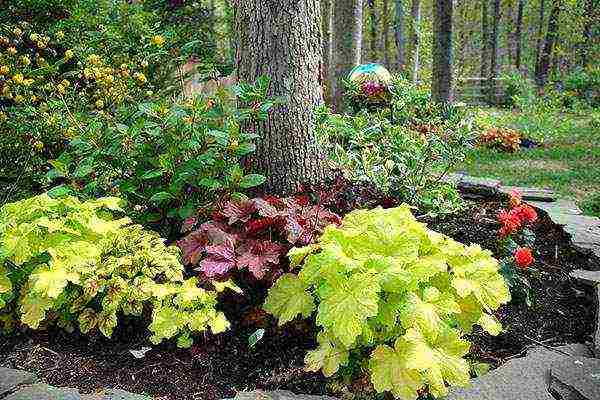 For a long time, Heuchera practically did not stand out among garden plants. She can be compared to a modest rural girl who dreams of becoming a princess. And now, the long-awaited moment has come: the breeders paid attention to the flower. As a result of their painstaking work, original views of the newly-made princess appeared in the garden.
For a long time, Heuchera practically did not stand out among garden plants. She can be compared to a modest rural girl who dreams of becoming a princess. And now, the long-awaited moment has come: the breeders paid attention to the flower. As a result of their painstaking work, original views of the newly-made princess appeared in the garden.
Botanical characteristics of Heuchera
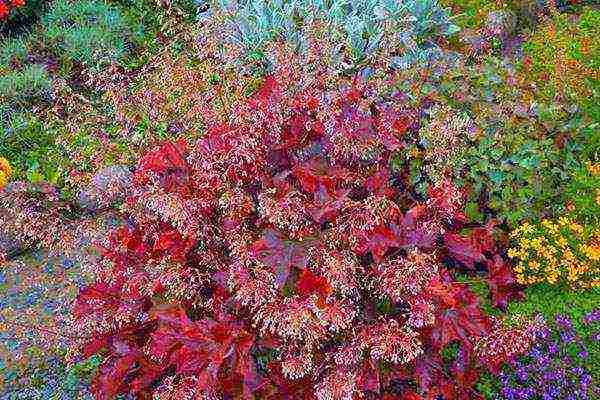 The flower belongs to the perennial colorful plants of the famous herbal family "Saxifrage". For the first time, the flower was noticed on the rocky mountain slopes of the North American prairies. It received its exclusive name Heicher in memory of the German scientist J.G. von Heicher. He was a renowned physician, biologist and, of course, a fan of green plants.
The flower belongs to the perennial colorful plants of the famous herbal family "Saxifrage". For the first time, the flower was noticed on the rocky mountain slopes of the North American prairies. It received its exclusive name Heicher in memory of the German scientist J.G. von Heicher. He was a renowned physician, biologist and, of course, a fan of green plants.
An unusual flower looks like a half-meter rounded bush from the side. Its main feature is its luxurious leaves. Many believe that this plant is a real gourmet. In one season, it is able to change the color of the leaves several times. No other garden flower has as many color options for the leaf plate as Heuchera.
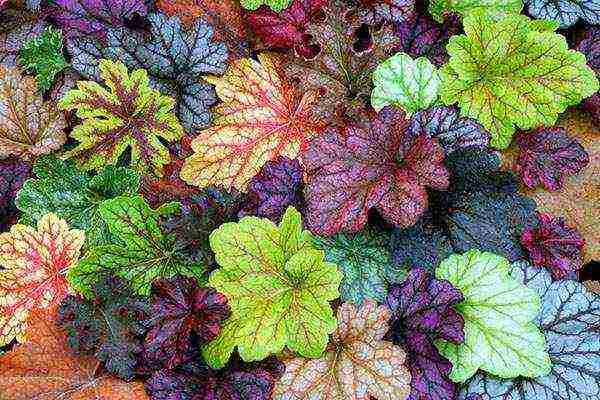 Its dense original bush consists of many leathery leaves with jagged edges. Each of them rests on a long handle and has a special texture:
Its dense original bush consists of many leathery leaves with jagged edges. Each of them rests on a long handle and has a special texture:
- with a smooth surface;
- corrugated;
- curly character.
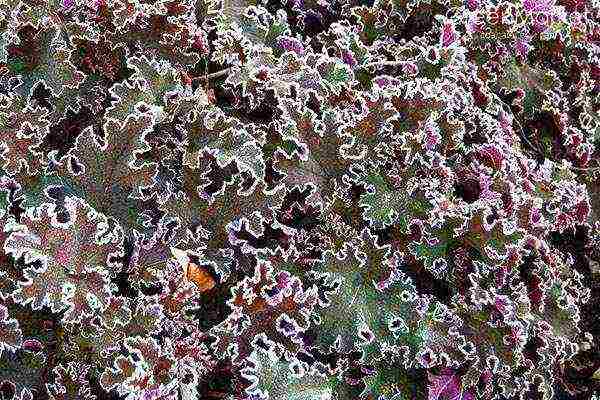 Their colors are especially impressive:
Their colors are especially impressive:
In addition, the leaves are:
- patterned;
- streaked;
- in small dots;
- with shapeless spots.
Heuchera blooms in early summer with small cute buds, which are collected in original panicles. They resemble bells in shape, therefore, looking at them, it seems that they will now ring. Exclusive photos of Heuchera varieties during flowering and lush decoration help to appreciate the unusual garden princess. The colors and shades of the buds are clearly visible on them:
Only with the arrival of autumn, in place of the buds, fruits in the form of a box are formed. By the time of full ripening, more than 20 thousand seeds, the size of a poppy seed, are stored in it.
Due to its wide variety and detailed description of geychera, it is quite often used to decorate the backyard area. And designers create unique landscape masterpieces from a colorful flower.
Color harmony in landscape design
If geykhera was once in the role of Cinderella in a flowerbed, today she is the leader in the list of contenders for decorating a flower zone. The varieties bred by breeders never cease to amaze lovers of garden creativity. Therefore, a magnificent plant - heuchera, has taken its place of honor in landscape design. It can be seen in various green compositions:
The bright leaves of Heuchera serve as an irreplaceable accent of the green garden planting throughout the season. They are used for a harmonious transition from plant to plant. Thus, the void of the site is completely filled during the flower off-season.
Heuchera does not require special care. It takes root well in the sun and shady places. Frost resistant. Reproduces easily. Doesn't get sick.
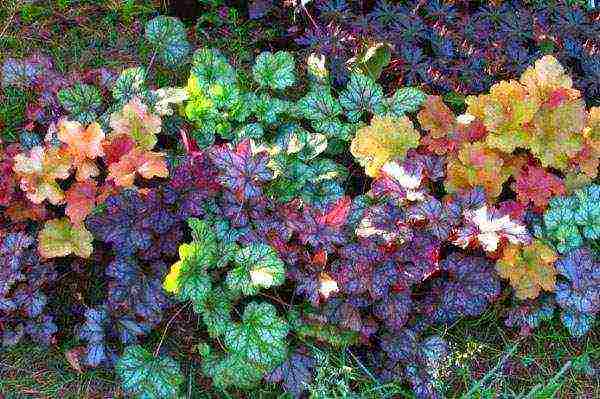 In the shown photo, Heuchera looks wonderful in the company of its relatives. The variety of shades of its leaves allows you to create a motley multi-colored corner on the site.
In the shown photo, Heuchera looks wonderful in the company of its relatives. The variety of shades of its leaves allows you to create a motley multi-colored corner on the site.
Many gardeners noted that working with Heuchera is a pleasure. It harmoniously combines with any plants in the summer cottage and always looks royally.
Surrounded by charming varieties of Heuchera
Many people believe that the only queen of the garden is the rose. Indeed, it is beyond competition. But thanks to the hard work of breeders, Heuchera can be put in the place of a pretty princess. After all, the abundance of various colors and forms of flower foliage and original paniculate buds has no analogues among plants. Considering the photos provided below with the names of species and varieties of Heuchera, let's try to plunge into the charming world of flowers.
The unsurpassed blood-red Heuchera
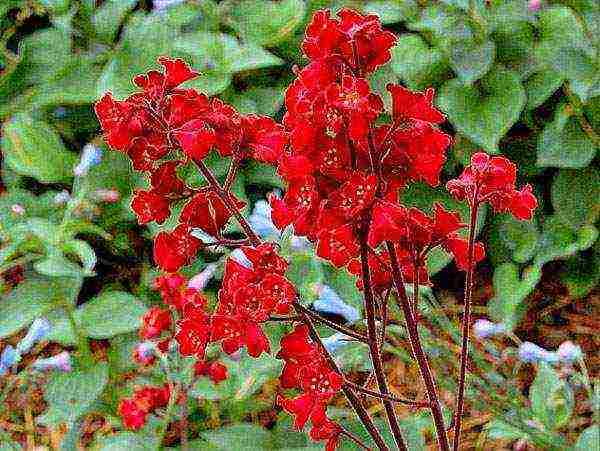 This type of flower is considered the ancestor of most varieties of this cute plant. Heuchera blood-red belongs to a very hardy mountain species. Because of its pretty small buds, the flower is called a coral bell. The leaf plates are mostly green. Some specimens are distinguished by refined marbling in a light green tone. The foliage is very dense to the touch, in comparison with other types of heuchera. Their shape is round, the edges are jagged, which looks quite stylish against the background of other plants. Strikingly, some varieties of blood-red heuchera have white or cream spots on the leaves.
This type of flower is considered the ancestor of most varieties of this cute plant. Heuchera blood-red belongs to a very hardy mountain species. Because of its pretty small buds, the flower is called a coral bell. The leaf plates are mostly green. Some specimens are distinguished by refined marbling in a light green tone. The foliage is very dense to the touch, in comparison with other types of heuchera. Their shape is round, the edges are jagged, which looks quite stylish against the background of other plants. Strikingly, some varieties of blood-red heuchera have white or cream spots on the leaves.
Small buds are originally collected in a slender panicle. They are often colored red, coral or pink. Cute bells attract not only insects, but also connoisseurs of natural beauty.
Historical facts show that some Indian tribes used the blood-red flowers of Heuchera to treat various ailments. If you grow up such a beauty in your country house, you can "recover" only from her presence.
"Tasty" Heuchera Marmalade
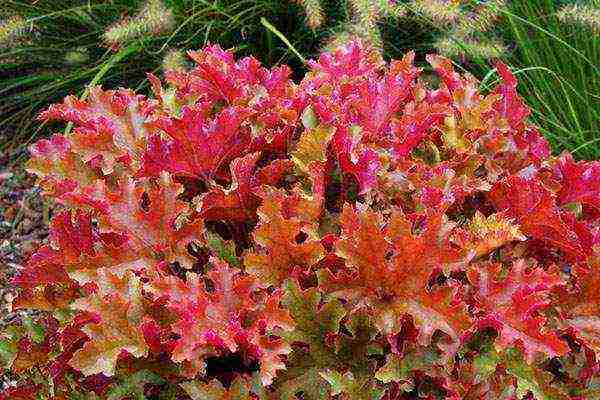 When you hear the word marmalade, a pleasant aftertaste appears in the mouth. And when you see flowers that look like candy, you get a sweet pleasure. Geichera Marmalade is considered one of the most common varieties of this class of plants. Its dense leaves of carved texture amaze with their variety of shades:
When you hear the word marmalade, a pleasant aftertaste appears in the mouth. And when you see flowers that look like candy, you get a sweet pleasure. Geichera Marmalade is considered one of the most common varieties of this class of plants. Its dense leaves of carved texture amaze with their variety of shades:
- yellow;
- orange;
- bright red;
- with a red underside:
- with a purple back of the leaf.
They are collected in a lush root rosette that looks gorgeous on a flower bed. The plant develops very quickly and is not afraid of the winter cold. It is used in various designs of the garden landscape.
Purple Heuchera Forever Purple
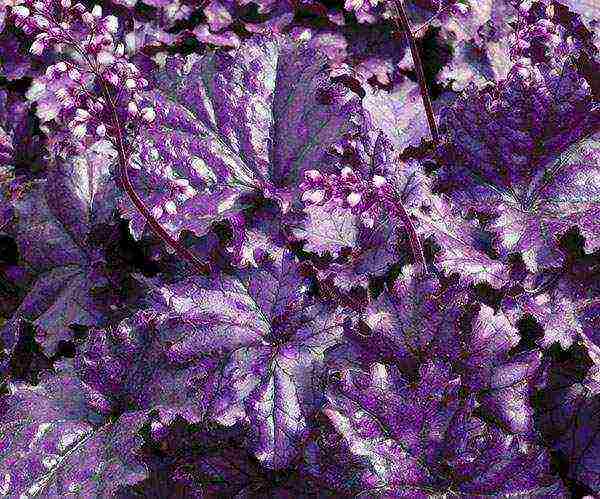 Unusually beautiful purple bushes about 55 cm wide and up to 30 cm high, harmoniously fit into any garden front garden. Geykhera Forever Purple amazes its fans with openwork leaves.Their rich purple color remains unchanged throughout the growing season.
Unusually beautiful purple bushes about 55 cm wide and up to 30 cm high, harmoniously fit into any garden front garden. Geykhera Forever Purple amazes its fans with openwork leaves.Their rich purple color remains unchanged throughout the growing season.
Buds in the form of small bells are located on low peduncles. They are collected in paniculate inflorescences and are painted in a light purple hue. Flowers are barely visible against the backdrop of lush foliage, but this gives the plant an unrivaled charm.
Fire Heuchera Cajun Fire
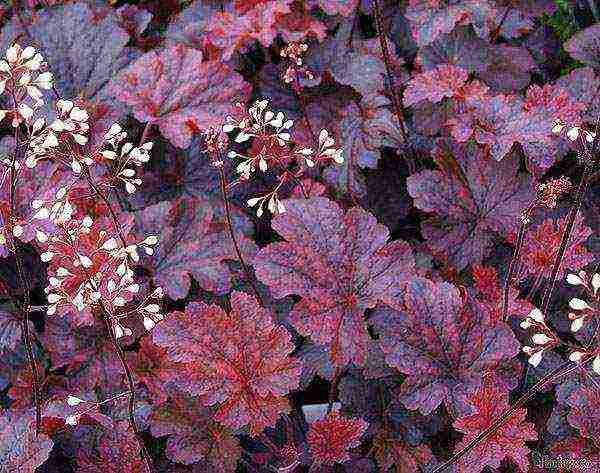 Try to imagine a fire burning amidst lush blooming plants. Someone will say: "This is impossible." In fact, Cajun Fire is such a "fire". The main feature of the species is a change in the color of large leaves of a matte nature. In early spring, they are deep red. In summer, it is almost black in color, with a barely noticeable hint of red. When autumn comes, the leaves turn burgundy. A truly glamorous chameleon.
Try to imagine a fire burning amidst lush blooming plants. Someone will say: "This is impossible." In fact, Cajun Fire is such a "fire". The main feature of the species is a change in the color of large leaves of a matte nature. In early spring, they are deep red. In summer, it is almost black in color, with a barely noticeable hint of red. When autumn comes, the leaves turn burgundy. A truly glamorous chameleon.
Heuchera reaches a height of about 25 cm. It grows rather quickly. It tolerates winter frosts perfectly. It blooms with white buds for the first two summer months. They modestly rise above the bush, which attracts the glances of people passing by.
Gentle Heuchera Cherry Cola
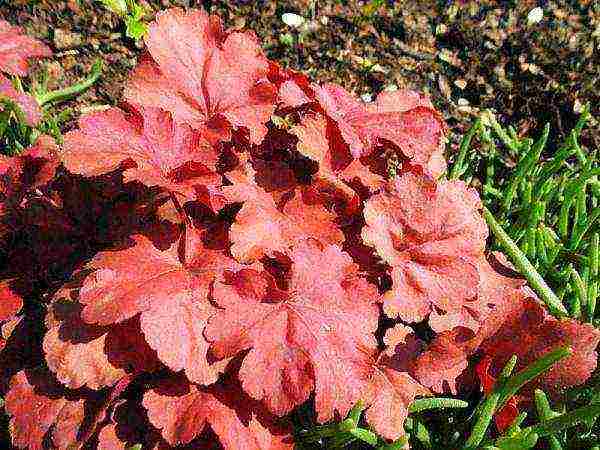 A small, cute bush with rounded wavy foliage is an indispensable decoration for a summer cottage. Interestingly, when the leaves age, they change their color. From orange or reddish color, matte leaf plates turn yellowish with a green tint.
A small, cute bush with rounded wavy foliage is an indispensable decoration for a summer cottage. Interestingly, when the leaves age, they change their color. From orange or reddish color, matte leaf plates turn yellowish with a green tint. 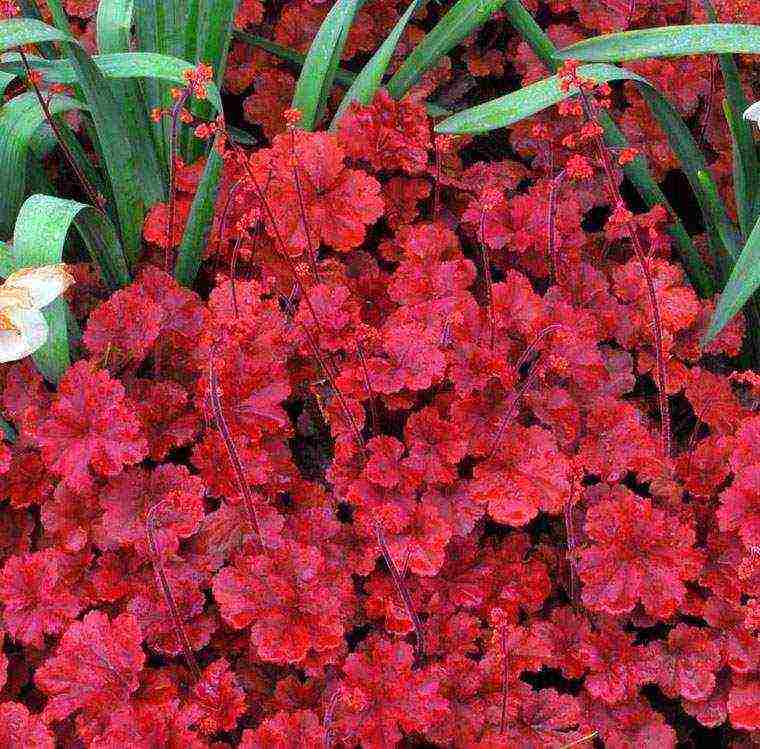 Cherry Cola flower stalks are colored brown, which is almost imperceptible behind coral or red buds.
Cherry Cola flower stalks are colored brown, which is almost imperceptible behind coral or red buds.
Since the flower grows very slowly, and its maximum height is about 20 cm, it is advisable to think about this before starting to form a garden flower bed.
Silver Heuchera Glitter
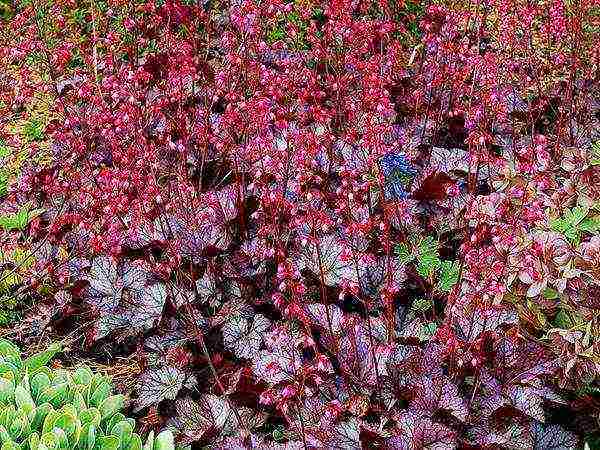 Most often, the plant grows up to 25 cm in height and is distinguished by unusual silver leaves. Black streaks are visible on each of them. The back of the leaf plate of Heuchera Glitter is painted in a lavender shade. It is interesting that in spring pink leaves bloom on the plant, which over time "dress" in silver. The buds are usually large. They resemble fuchsia in appearance. Blossom in June and bloom magnificently until early September.
Most often, the plant grows up to 25 cm in height and is distinguished by unusual silver leaves. Black streaks are visible on each of them. The back of the leaf plate of Heuchera Glitter is painted in a lavender shade. It is interesting that in spring pink leaves bloom on the plant, which over time "dress" in silver. The buds are usually large. They resemble fuchsia in appearance. Blossom in June and bloom magnificently until early September.
"Sweet" Heuchera Caramel
 When you see a plant with golden-orange leaves in the garden, reminiscent of sweet caramel, you involuntarily want to taste them. In fact, we have before us a refined Heuchera Caramel, which can be admired for an infinitely long time. Its large leaves, barely emerging in spring, are colored red. Over time, they become yellow or amber. The scarlet shade remains only on the back. During lush flowering, flower stalks appear on the bushes with creamy buds in the form of small bells.
When you see a plant with golden-orange leaves in the garden, reminiscent of sweet caramel, you involuntarily want to taste them. In fact, we have before us a refined Heuchera Caramel, which can be admired for an infinitely long time. Its large leaves, barely emerging in spring, are colored red. Over time, they become yellow or amber. The scarlet shade remains only on the back. During lush flowering, flower stalks appear on the bushes with creamy buds in the form of small bells.
Majestic Heychera Purple Castle
 Under such a chic name, the totality of all varieties of small-flowered heuchera is classified. They are distinguished by the abundant presence of branched rhizomes, which promotes rapid reproduction. As a result, the plant is used to decorate the borders along the garden paths. It is also considered an indispensable attribute in the creation of rock gardens.
Under such a chic name, the totality of all varieties of small-flowered heuchera is classified. They are distinguished by the abundant presence of branched rhizomes, which promotes rapid reproduction. As a result, the plant is used to decorate the borders along the garden paths. It is also considered an indispensable attribute in the creation of rock gardens.
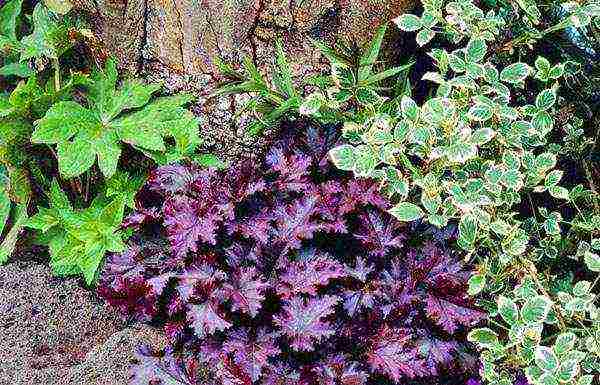 Heuchera has large burgundy purple leaf plates. The original color makes the plant indispensable in the garden bed throughout the summer. Interestingly, in ancient times, purple paint was considered one of the most expensive goods of itinerant merchants. Having planted the Purple Castle Heuchera on a summer cottage, it is quite possible to feel like the owner of a valuable "pearl".
Heuchera has large burgundy purple leaf plates. The original color makes the plant indispensable in the garden bed throughout the summer. Interestingly, in ancient times, purple paint was considered one of the most expensive goods of itinerant merchants. Having planted the Purple Castle Heuchera on a summer cottage, it is quite possible to feel like the owner of a valuable "pearl".
Another purple beauty - Heychera Melting Fire
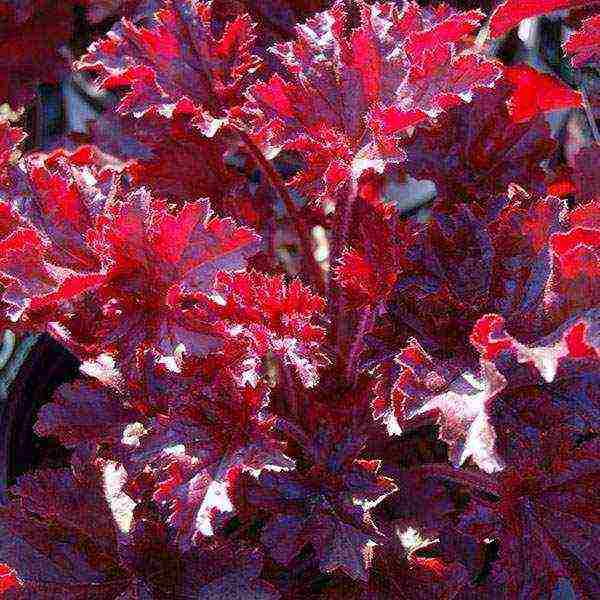 When the plant is just blooming in early spring, its leaves are purple-reddish. But over time, they become darker, acquiring a special saturation. The back of the leaf plate of the flower has a red tint. When exposed to sunlight, an unusual shine appears. A truly amazing sight.
When the plant is just blooming in early spring, its leaves are purple-reddish. But over time, they become darker, acquiring a special saturation. The back of the leaf plate of the flower has a red tint. When exposed to sunlight, an unusual shine appears. A truly amazing sight.
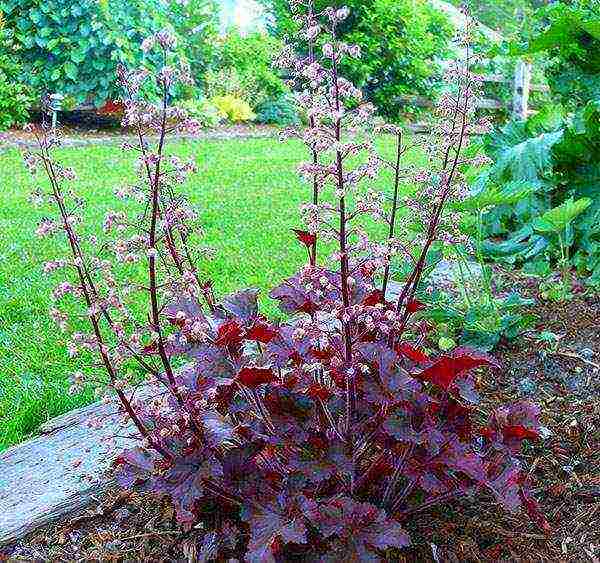 Heuchera Melting Fire forms a compact bush of rosette leaves with a wavy structure. On erect peduncles, openwork small buds bloom, resembling miniature bells. During lush bloom, they are dazzling white.
Heuchera Melting Fire forms a compact bush of rosette leaves with a wavy structure. On erect peduncles, openwork small buds bloom, resembling miniature bells. During lush bloom, they are dazzling white.
Multicolored Heuchera Zipper
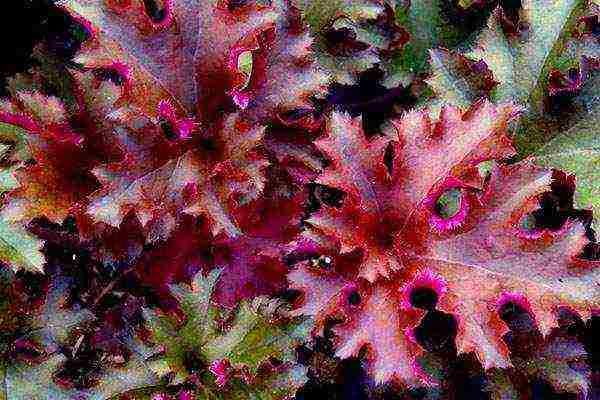 For lovers of colorful flowers, the Heuchera Zipper is suitable. It differs in the following shades:
For lovers of colorful flowers, the Heuchera Zipper is suitable. It differs in the following shades:
- Orange;
- amber;
- golden.
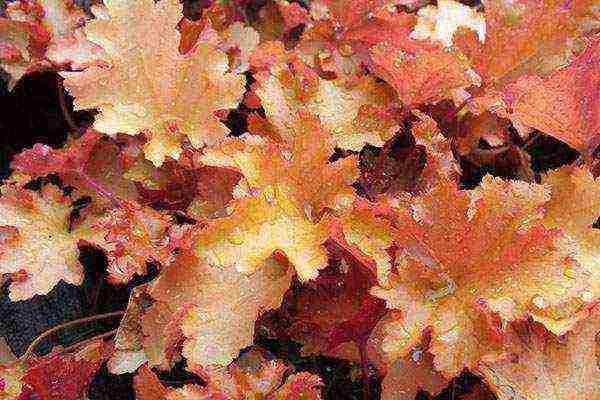 It is especially striking that the flower changes color over time. Leaves are orange in spring and golden in summer. The back of them is painted purple, which gives the plant a kind of intricate charm. Heuchera blooms in July with white or creamy small bells.
It is especially striking that the flower changes color over time. Leaves are orange in spring and golden in summer. The back of them is painted purple, which gives the plant a kind of intricate charm. Heuchera blooms in July with white or creamy small bells.
Spotted Heuchera Midnight Rose
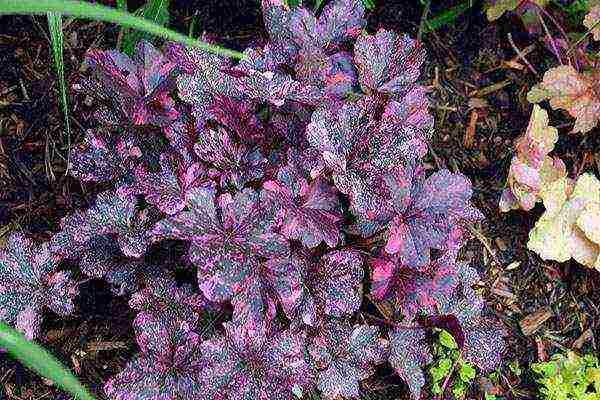 In 2008, at an exhibition of garden plants in England, Heuchera Midnight Rose was recognized as one of the best varieties of green spaces. It is distinguished by an incredibly rich color of the heart-shaped foliage of a miniature bush. Most often it is a maroon shade, on which pink spots are scattered. The plant grows to about 25 cm and blooms in early June in small bells.
In 2008, at an exhibition of garden plants in England, Heuchera Midnight Rose was recognized as one of the best varieties of green spaces. It is distinguished by an incredibly rich color of the heart-shaped foliage of a miniature bush. Most often it is a maroon shade, on which pink spots are scattered. The plant grows to about 25 cm and blooms in early June in small bells.
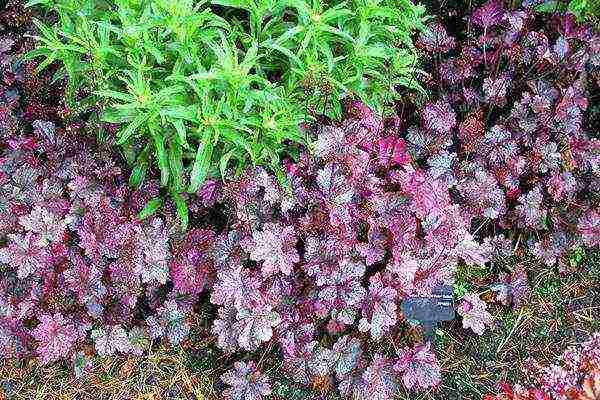 The name of this variety - Heuchera Midnight Rose reminds of the unchanging queen of the garden. It is this plant that can rightfully be attributed to the royal nobility in the world of flowers.
The name of this variety - Heuchera Midnight Rose reminds of the unchanging queen of the garden. It is this plant that can rightfully be attributed to the royal nobility in the world of flowers.
Geichera Palace Purple
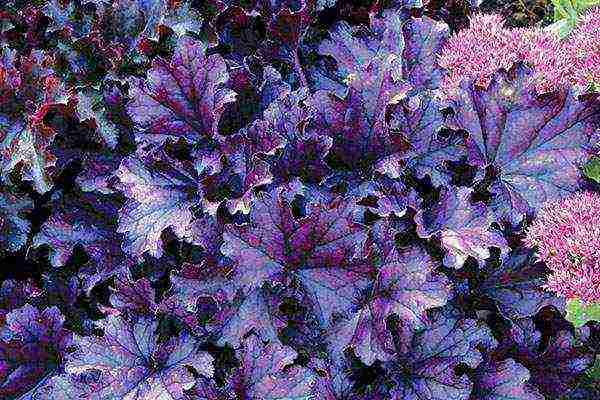 This variety has been used in horticulture since 1980. It was bred by combining several types of flower, one of which is a small-flowered plant variety. Despite its hybrid origin, the Palace Purple Heuchera is a perennial garden. She amazes with the beauty of her cherry leaves, which cover the soil with an incredibly lush carpet. In shape, the leaf blade resembles ivy or maple. On top it is painted in purple, and on the back with beetroot. If there is a prolonged heat in the summer, the leaves burn out, acquiring a bronze color.
This variety has been used in horticulture since 1980. It was bred by combining several types of flower, one of which is a small-flowered plant variety. Despite its hybrid origin, the Palace Purple Heuchera is a perennial garden. She amazes with the beauty of her cherry leaves, which cover the soil with an incredibly lush carpet. In shape, the leaf blade resembles ivy or maple. On top it is painted in purple, and on the back with beetroot. If there is a prolonged heat in the summer, the leaves burn out, acquiring a bronze color.
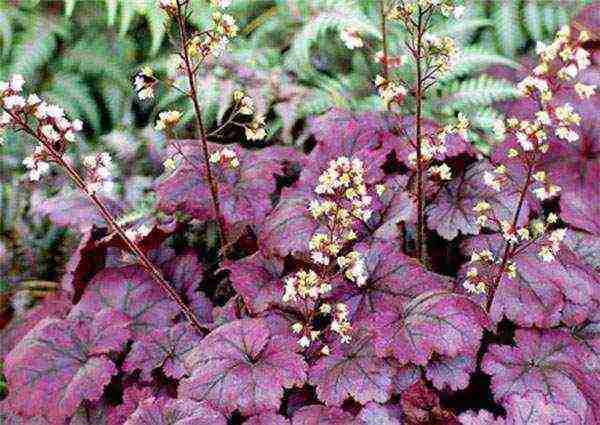 Bell-shaped buds are collected in paniculate inflorescences, which are located on erect peduncles. Most often they are beige and look original against the background of cherry foliage.
Bell-shaped buds are collected in paniculate inflorescences, which are located on erect peduncles. Most often they are beige and look original against the background of cherry foliage.
Geichera Hybrid
 Thanks to the unsurpassed talent of breeders, the hybrid Heuchera appeared. One of the popular varieties of this class of plants is the American Heuchera. It was obtained by crossing three starting materials: small-flowered, American and hairy Heuchera.
Thanks to the unsurpassed talent of breeders, the hybrid Heuchera appeared. One of the popular varieties of this class of plants is the American Heuchera. It was obtained by crossing three starting materials: small-flowered, American and hairy Heuchera.
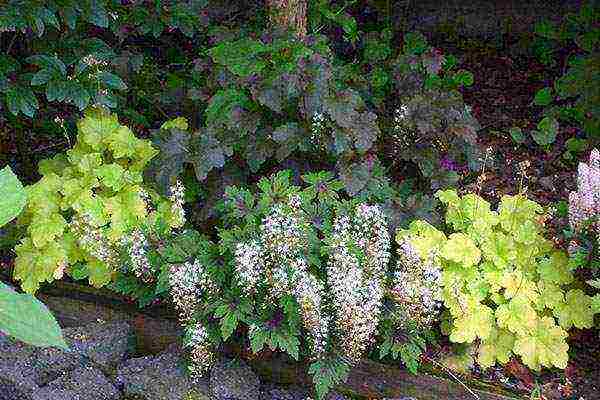 The plant may have leaf blades with blunt or sharp tips. And the frame is almost always wavy in nature. They are painted purple, violet and brown. During flowering, graceful bells appear on the bushes of the hybrid heuchera.
The plant may have leaf blades with blunt or sharp tips. And the frame is almost always wavy in nature. They are painted purple, violet and brown. During flowering, graceful bells appear on the bushes of the hybrid heuchera.
Geichera Comet
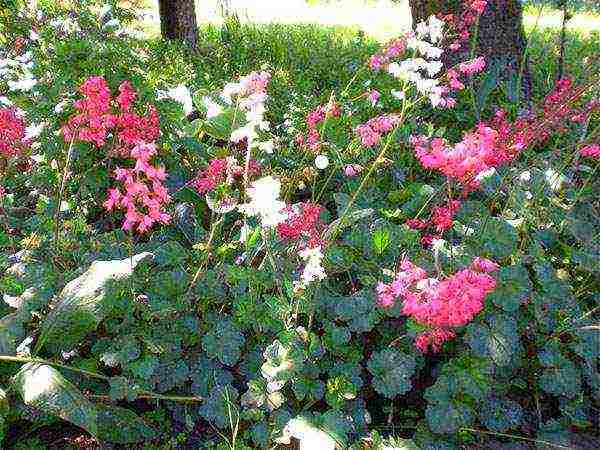 The unusual name of the plant hints at an "unearthly" origin. Geichera Comet is distinguished by serrated leaves with a delicate edge. They come out compactly from the main rhizome and form a beautiful rosette. A slender peduncle about 40 cm high, decorated with small red buds, rises from its center. Bright bells gently sway even with a light breeze, which attracts new fans. A truly wonderful flower!
The unusual name of the plant hints at an "unearthly" origin. Geichera Comet is distinguished by serrated leaves with a delicate edge. They come out compactly from the main rhizome and form a beautiful rosette. A slender peduncle about 40 cm high, decorated with small red buds, rises from its center. Bright bells gently sway even with a light breeze, which attracts new fans. A truly wonderful flower!
Wonderful Heuchera in the garden - video
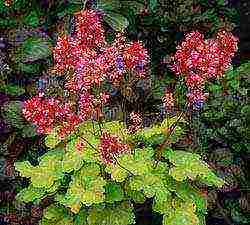 It is not difficult to grow Heuchera outdoors, you just need to choose the right place for planting the plant. Many varieties grow and reproduce well even in the mountainous regions of North America, so caring for Heuchera in our latitudes is very simple, because it can grow even on rocky soil. In addition, its decorativeness and versatility will bring new shades into any landscape design.
It is not difficult to grow Heuchera outdoors, you just need to choose the right place for planting the plant. Many varieties grow and reproduce well even in the mountainous regions of North America, so caring for Heuchera in our latitudes is very simple, because it can grow even on rocky soil. In addition, its decorativeness and versatility will bring new shades into any landscape design.
Description of geychera: varieties and varieties
So, what is this miracle - Heuchera? An evergreen perennial plant with a height of 40-60 cm. The leaves are medium in size, round in shape, sit on long petioles and form a rosette at the root. Heuchera blooms from late May until autumn. The flowers form a panicle inflorescence about 20 cm long.After flowering, fruit boxes with seeds are formed.

Heuchera decorative deciduous
The cultivated varieties of Heuchera can be conditionally divided into two categories:
- decorative deciduous;
- decorative blooming.
Heuchera is decorative with its foliage: no other plant has such a variety of palettes and leaf textures. Heuchera flowers noticeably lose to the leaves, but there are varieties that are valued precisely for the inflorescences, they create an excellent color contrast with the foliage of the plant.
To date, about 400 varieties of Heuchera have already been bred, their shades and varieties will satisfy the most refined taste and will find their place in any landscape design.
At the moment, cylindrical, American and blood-red varieties of Heuchera are especially popular. Now let's look at these varieties in more detail with a photo.
- Heichera blood red... It has denser leaves than other plant species. This species is the most popular; other varieties of Heucher were developed on its basis. Bell-shaped flowers, color from red to pink. Blooms from June to August. Easy to care for, drought tolerant, but requires shade planting. The most famous varieties: Monet, Hercules, Robusta.
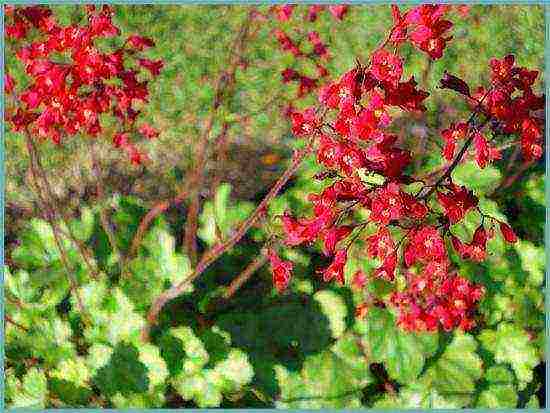
Heichera blood red
- American Geichera... It is a cultivar with rounded leaves and yellow-green flowers. The variety is distinguished by a variety of foliage colors, shades and borders. In spring and autumn, the leaves have the most intense hue, in summer it becomes paler.
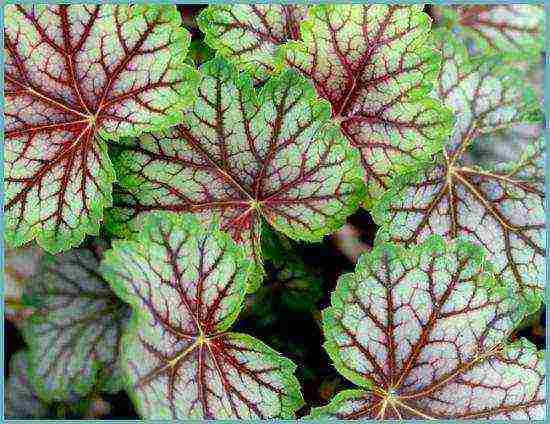
American Geichera
- Heuchera is cylindrical. This variety of Heuchera is larger than the others, preferring sunny places or a little partial shade. Cylindrical inflorescences: green, coral or red. Leaves are green.
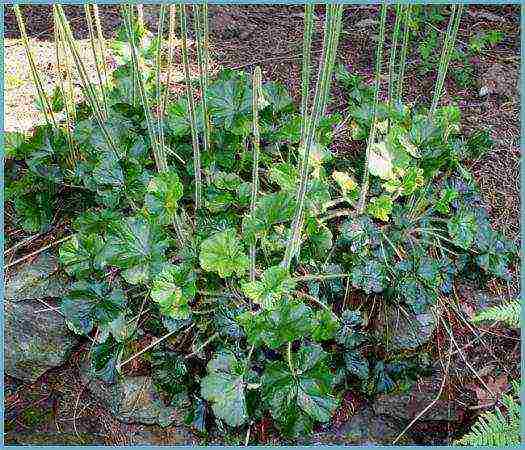
Heuchera cylindrical
- Heuchera small-flowered... The most famous variety "Purple Castle" is very popular, has bright purple leaves with a metallic sheen. Frost-resistant and drought-resistant, easy to care for, moreover, keeps leaves under the snow until spring.
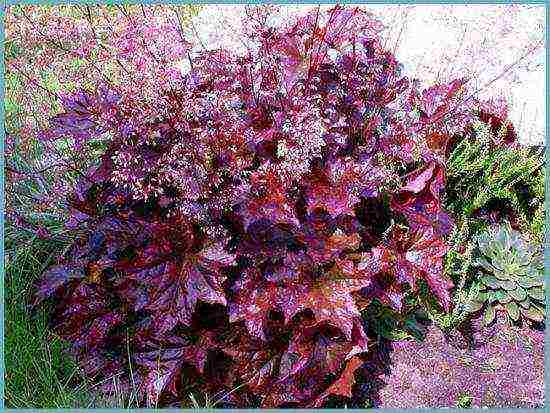
Heuchera small-flowered
Planting a plant
Before planting, you need to choose a place and prepare the soil. Geykhera combines well with other perennials and is not aggressive towards them, so it can be safely planted in a company with other types of plants or a flowerbed made of different varieties of geykhera.
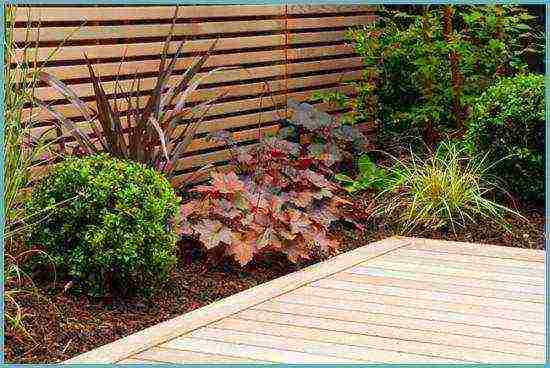
The plant feels great in any neighborhood
The plant prefers light and nutritious soils where water does not stagnate. Acidic soil does not suit her. Before planting, you need to add coarse river sand or pebbles to the soil. Saplings should be planted in May at a distance of 20-25 cm and watered regularly, but not waterlogged, otherwise the plant may die. Heuchera can be planted in open ground by seeds, cuttings, or by separating the rosette of an adult bush.
Plant care
As for leaving, in this regard, Heuchera is very unpretentious. But there are some conditions, and these are:
- diffused shadow;
- deep drainage;
- permeable soil.
Heuchera, planted in the shade of trees or in partial shade, will retain its decorative effect, since it needs the sun in the morning. It is worth planting varieties with red leaves on sunny areas, it is in the sun that they will turn red, but in the shade they will remain green. But many varieties adapt to the sun - the silvery mosaic of their foliage takes on a richer color, and the heuchera with purple foliage darkens.
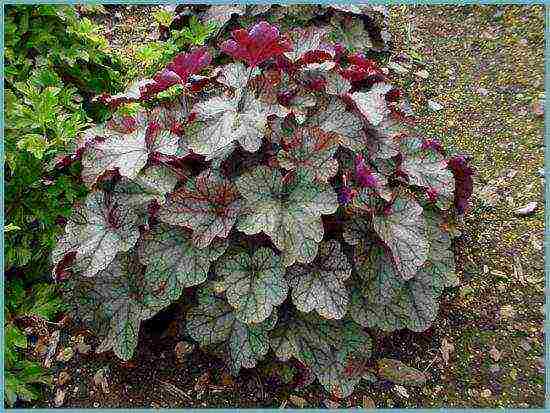
In the shade, heuchera leaves will acquire rich shades.
The root system of Heuchera is shallow, so it is important to protect the roots from drying out. It is best to apply mulching. Mulch will retain moisture, the soil beneath it breathes and is structured by soil inhabitants. As mulch, you can use straw, sawdust, compost, tree bark, foliage, expanded clay screenings, gravel, peat.
The soil must be permeable - from stagnant water, the plant can get sick and die.Therefore, you should take care of drainage even when planting a plant.
Aging heuchera bushes lose their decorative effect - the middle of the bush is exposed. In this case, you need to rejuvenate the bush: dig up the plant, divide it into parts and plant it. This should be done at the end of summer after flowering or in spring before the leaves open. Heuchera tolerates these manipulations painlessly and immediately starts to grow.
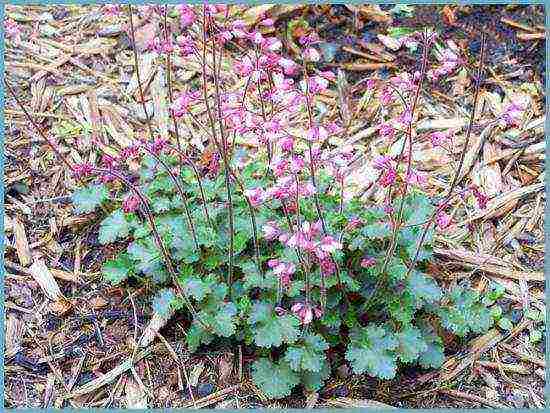
Soil mulching will help Heuchera maintain moisture balance
Dried foliage is not removed in winter - it helps the plant to overwinter, covers the roots and retains heat. Remove only inflorescences with seeds - after flowering, they spoil the decorative appearance. In the future, the collected seeds can be used for propagation and cultivation of Heuchera in the open field. Varieties with light foliage and young bushes for the winter need to be additionally covered with foliage.
Advice. Water the plants early in the morning or in the evening, drops of water in the sun can burn the leaves.
Fertilizer and feeding of Heuchera
Before being domesticated by man, Heuchera grew in the mountains, where the soil is rather scarce. Modern varieties are still not far from their wild relatives, so they do not complain about the small amount of nutrients in the soil. Mineral fertilizers are rarely used. Better to limit yourself to one dressing in the spring in the first year after planting. If you did not do this in spring, then feed Heuchera with mineral complex fertilizer for deciduous plants at the end of the growing season. After fertilizing, be sure to water the bushes.
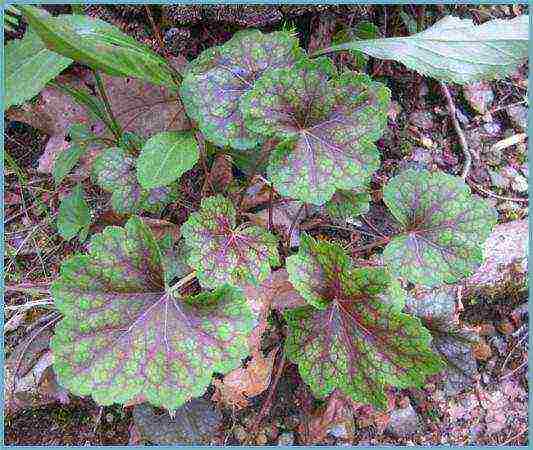
There is no need for regular plant feeding
Important. When applying fertilizers, be sure to halve the dose recommended by the manufacturer on the package.
Plant propagation
Reproduction by dividing the bush is the simplest way, which preserves the decorativeness of the variety. This is done in early spring or autumn. Separate the rosette from the adult plant and transplant a little deeper than the mother plant was planted.
The second way is grafting. A 4-6 cm stalk is cut from the bush in the summer and rooted in a greenhouse. The process takes 3-4 weeks, after which the finished plant can be planted.
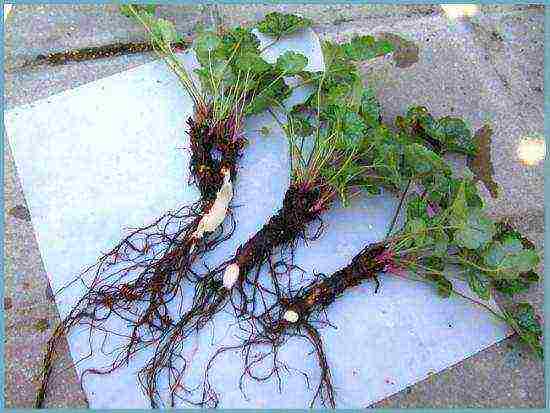
Division of the heuchera bush
Diseases and pests
As for diseases, Heuchera is unique in that it practically does not get sick in the open field, and is rarely affected by pests. But sometimes it can suffer from powdery mildew, rust, gray mold or leaf blight. This can happen if the plant is frequently watered, or the soil is poorly drained and the water stagnates at the roots, creating an ideal environment for pathogens to thrive. From an excess of fertilizers, the plant "fattens", which leads to a weakening of the immune system. Powdery mildew can be defeated by spraying with a fungicide, after removing diseased leaves, and the Bordeaux mixture will cope with spotting and rust.
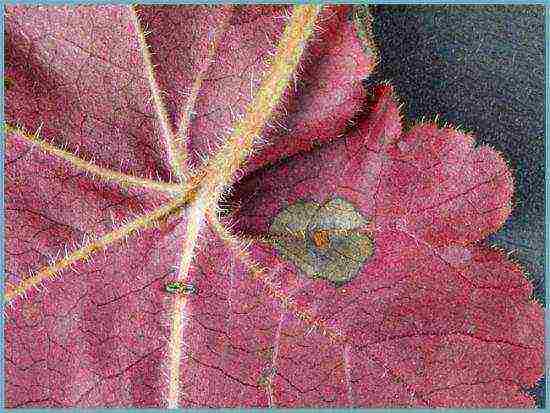
Rust on a Heuchera leaf
As for pests, the danger to the plant is posed by the beetle larvae, which can gnaw at the roots, grape snails, slugs, caterpillars and leaf nematodes, which can be removed with an insecticide.
Advice. Slugs hide in secluded places from the sun during the day, so you can put a board, slate, cardboard or a piece of old linoleum near the heuchera, and collect slugs under them in the morning.
Heuchera: combination with other plants
Thanks to the contrasting combination of heuchera leaves with the leaves of other plants, you can create unique compositions. Geuchera is planted with hosts, kupen, ferns, hellebores, daylilies, combined with decorative cereals, bruner, irises, barberries.
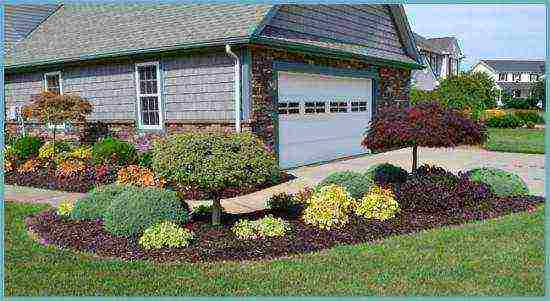
Heuchera will decorate your garden even in autumn, when other plants have faded
Heuchera goes well with tall conifers, acts as an addition for short roses. In spring, it is good to place with tulips: after they have faded, the flower bed is not empty.
Geichera in landscape design
Do not be afraid to experiment with planting Heuchera in your area. Like precious stones, Heuchera will decorate any flower garden; no other flower culture has such a rich palette with an abundance of colors and shades.
A huge advantage of Heuchera is its decorative effect during the entire growing season and ease of maintenance. Heuchera is grown both in single plantings of the same species, and in mixed ones, used as a perennial ground cover plant. With its compact bush shape, Heuchera is an ideal companion to combine with other plants. This is a real find for those cases when you need to fill the space in the flower garden or highlight the dignity of another plant, highlight the planting of conifers.
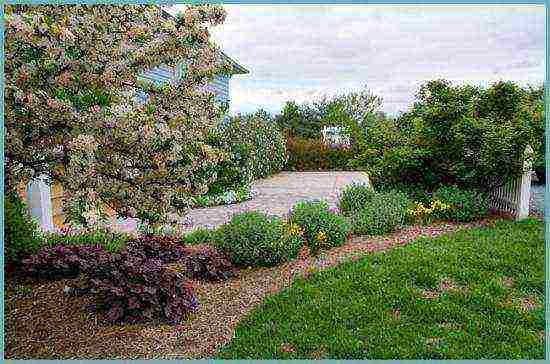
Geichera in landscape design
Geykhera does not lose its decorative shape with age, therefore it will ideally fit into flower beds of strict geometric shapes, mask unsightly areas. Geichera is suitable for creating alpine slides, rocky gardens, borders, decoration of terraces and gazebos. She can decorate garden sculptures, slides and fountains. Often used for planting in ceremonial flower beds.
In the first year after planting Heuchera, it will be difficult to assess its merits in landscape design - just planted, it will not yet become such a magnificent beauty, but already in the next season you will be able to enjoy the density of colors.
Heuchera varieties and their cultivation: video
Geichera: photo

